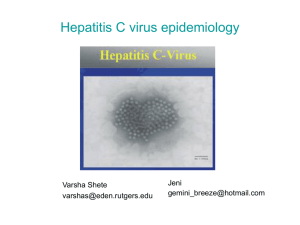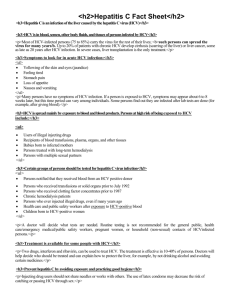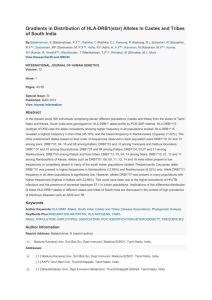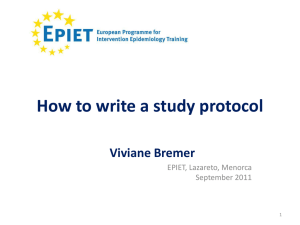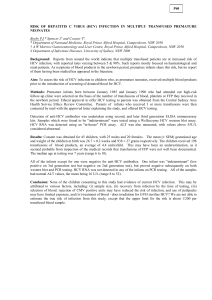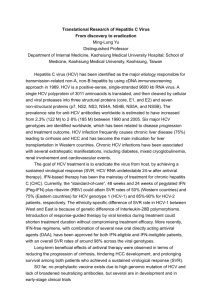Document 14111191
advertisement
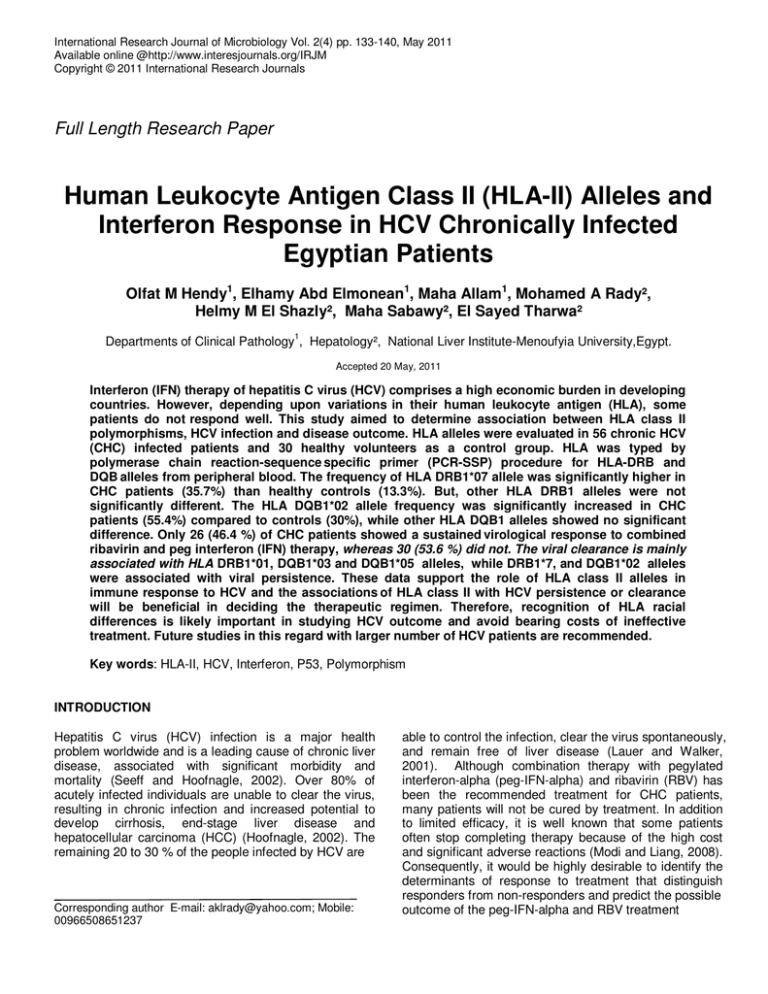
International Research Journal of Microbiology Vol. 2(4) pp. 133-140, May 2011 Available online @http://www.interesjournals.org/IRJM Copyright © 2011 International Research Journals Full Length Research Paper Human Leukocyte Antigen Class II (HLA-II) Alleles and Interferon Response in HCV Chronically Infected Egyptian Patients Olfat M Hendy1, Elhamy Abd Elmonean1, Maha Allam1, Mohamed A Rady², Helmy M El Shazly², Maha Sabawy², El Sayed Tharwa² Departments of Clinical Pathology1, Hepatology², National Liver Institute-Menoufyia University,Egypt. Accepted 20 May, 2011 Interferon (IFN) therapy of hepatitis C virus (HCV) comprises a high economic burden in developing countries. However, depending upon variations in their human leukocyte antigen (HLA), some patients do not respond well. This study aimed to determine association between HLA class II polymorphisms, HCV infection and disease outcome. HLA alleles were evaluated in 56 chronic HCV (CHC) infected patients and 30 healthy volunteers as a control group. HLA was typed by polymerase chain reaction-sequence specific primer (PCR-SSP) procedure for HLA-DRB and DQB alleles from peripheral blood. The frequency of HLA DRB1*07 allele was significantly higher in CHC patients (35.7%) than healthy controls (13.3%). But, other HLA DRB1 alleles were not significantly different. The HLA DQB1*02 allele frequency was significantly increased in CHC patients (55.4%) compared to controls (30%), while other HLA DQB1 alleles showed no significant difference. Only 26 (46.4 %) of CHC patients showed a sustained virological response to combined ribavirin and peg interferon (IFN) therapy, whereas 30 (53.6 %) did not. The viral clearance is mainly associated with HLA DRB1*01, DQB1*03 and DQB1*05 alleles, while DRB1*7, and DQB1*02 alleles were associated with viral persistence. These data support the role of HLA class II alleles in immune response to HCV and the associations of HLA class II with HCV persistence or clearance will be beneficial in deciding the therapeutic regimen. Therefore, recognition of HLA racial differences is likely important in studying HCV outcome and avoid bearing costs of ineffective treatment. Future studies in this regard with larger number of HCV patients are recommended. Key words: HLA-II, HCV, Interferon, P53, Polymorphism INTRODUCTION Hepatitis C virus (HCV) infection is a major health problem worldwide and is a leading cause of chronic liver disease, associated with significant morbidity and mortality (Seeff and Hoofnagle, 2002). Over 80% of acutely infected individuals are unable to clear the virus, resulting in chronic infection and increased potential to develop cirrhosis, end-stage liver disease and hepatocellular carcinoma (HCC) (Hoofnagle, 2002). The remaining 20 to 30 % of the people infected by HCV are Corresponding author E-mail: aklrady@yahoo.com; Mobile: 00966508651237 able to control the infection, clear the virus spontaneously, and remain free of liver disease (Lauer and Walker, 2001). Although combination therapy with pegylated interferon-alpha (peg-IFN-alpha) and ribavirin (RBV) has been the recommended treatment for CHC patients, many patients will not be cured by treatment. In addition to limited efficacy, it is well known that some patients often stop completing therapy because of the high cost and significant adverse reactions (Modi and Liang, 2008). Consequently, it would be highly desirable to identify the determinants of response to treatment that distinguish responders from non-responders and predict the possible outcome of the peg-IFN-alpha and RBV treatment 134 Int. Res. J. Microbiol. (Hwang, 2006). Thus understanding the mechanism of therapeutic success and failure has important clinical relevance for developing improved therapies and predicting nonresponse. Patients who spontaneously clear infection have strong and broad T cell responses while patients with chronic HCV have weak and functionally impaired responses characterised by poor proliferation, impaired cytotoxicity and reduced cytokine secretion after antigen exposure (Hoofnagle, 2002). It is generally accepted that genes within the Major Histo-compatibility Complex (MHC) play a central role in the development of the immune response against HCV (Eckels et al., 2000). Apart from the virus itself, host factors that modulate the immune response are likely to be involved in determining the outcome of HCV infection (Tillmann et al., 2001). Several studies have addressed the issue of the association of Class II HLA alleles with the immunological control and clinical outcome after initial HCV infection. However, which genes are associated with one outcome or another seems to depend on the ethnicity of the infected subject (Thio et al., 2001). The majority of such studies have been focused on the associations between HLA class II alleles and HCV infection. In addition, the reported associations showed ethnic and geographical differences (Wedemeyer et al., 2002; Cursino-Santos et al 2007). One study of a Northeastern American population in Baltimore showed that HLA-DQB1*03 is protective in African Americans but not in Caucasians (Tillmann et al., 2001 7). The results of another study of North-eastern Americans in Philadelphia conversely suggested that DQB1*03 is protective in Caucasians but not in African Americans (Wedemeyer et al., 2002 9). Other associations have also been reported; for example, a British and Frensh group reported an association of HLA-DRB1*1101 and HLA-DQB1*0301 with HCV clearance in Caucasian populations (Minton EJ et al., 1998). In addition, a Japanese group reported association of HLA-DRB1*0405 and HLA-DQB1*0401 with chronic liver disease due to HCV (Kuzushita et al 1998 12). A Thai study demonstrated that HLADRB1*0301 and HLA-DQB1*0201 are associated with persistent HCV infection, whereas HLA-DRB1*0701 and HLA-DQA1*0201 are associated with protection against HCV infection (Dharakul, 2000). A Polish study showed the HLA-DRB1*0701-DQA1*0201-DQB1*02 haplotype to be associated with both chronic infection and response to IFN-alpha (Wawrzynowicz-Syczewska et al., 2000). An association of response to IFN with HLA-DR 2 and DRB1*0404 has been reported in Egyptian (Almarri et al., 1998 15) and Canadian (Sim et al., 1998) patients, respectively, but in both studies only the biochemical response was evaluated based on the decrease of the alanine aminotransferase level in serum during therapy and not the virological response (clearance of HCV-RNA in serum). Therefore, further study on ethnic and geographical differences in HLA associations with the outcome of HCV infection is needed. There has been little research in this field in Egypt, although HCV infection occurs at a moderately high rate in the population. Aim This study aimed to focus on HLA class II associations with chronic HCV infection and its relation to interferon based treatment outcome in Egyptian patients as a response predictor. Patients and methods The current study was conducted on 56 chronic HCV (CHC) patients from interferon clinic of National Liver Institute-Menoufiya University at the period from November 2009 to August 2010. All patients gave their written informed consent before the study. All patients had persistent (>6 months) elevation of alanine aminotransferase 1.5 times above the upper normal limit, with detectable HCV antibodies and HCV RNA with negative both HBs and HBe antigens with histological evidence of HCV. The stage of fibrosis was determined according to Ishak scoring system (Ishak et al 1995), fibrosis scale from 0-6, 0=no fibrosis, 1-2=portal fibrosis (mild fibrosis), 3-4=bridging fibrosis (moderate fibrosis) and 5-6= cirrhosis (advanced fibrosis). All CHC patients were submitted to an interferon therapy. Protocol of therapy: Patients will be stratified according to response to interferon therapy into two groups: The first group is the responders to interferon therapy, the CHC patients who had received a combination therapy of interferon and ribavirin and have shown negative HCV RNA by PCR 6 months (24 weeks) following completion of a 48 weeks course. The second group is the non responders to interferon therapy, the chronic HCV patients who had shown otherwise all patterns of interferon response than complete virological response (no disappearance of HCV RNA at the end of the 12 week, partial responders at 12 weeks but null response at 24 weeks, or breakthrough (those patients who showed complete response at 12 weeks but detectable HCV RNA at any time during course of treatment through 48 weeks). Thirty healthy volunteers where selected from bone marrow and organ transplant donors constituting a control group (19 males, 11 females; age range 28-51 years). The present study was approved by the ethical committee of National Liver Institute-Menoufiya University Hendy et al. 135 Table (1) Patient characteristics (N=56) Males Female Number (%) 34 (60.7%) 22 (39.3%) Surgical procedures Sexual Needle stick injuries Drug abuse Unknown Stage of liver Stage 0–1 fibrosis: Stage 2–3 Stage 4-6 16 (28.6%) 6 (10.7%) 10 (17.9%) 4 (7.1%) 20 (35.7%) 14 (25.0%) 32 (57.1%) 10 (17.9%) Gender: Mode of infection: The following investigations were done for all patients and controls - Liver function testes was done on Integra-400 (RocheGermany), HCV antibodies were done by EIA (COBASAmplicore, Germany). HCV-RNA levels were analyzed by reverse transcriptase polymerase chain reaction (RTPCR) using a commercial kit (Roche Diagnostic, Branchburg, NJ) according to the manufacturer's instructions. Complete blood counts were done on Sysmix KX-21 automatic cell counter (Japan). - Liver biopsy was done for all patients included at the beginning of therapy. - HLA-II typing by polymerase chain reactionsequence specific primer (PCR-SSP) The PCR-SSP was done according to Olerup and Zetterquist (Olerup O, Zetterquist et al 1992 18) method, in which, the discrimination between the different alleles takes place during the PCR process Procedure Blood samples (10 mL) were collected from the subjects in tubes containing anticoagulant (EDTA) and centrifuged at 2,500 rpm for 15 minutes, and the Buffy-coat was conserved at -70°C until use. The genomic DNA was extracted from blood sample by modified salting out method (Newton et al 1998) by QIAGEN EZ1 DSP DNA Blood System. In brief, 2 ml of whole blood was mixed with 8 ml of triton lysis buffer 1 (0.32M Sucrose, 5mM MgCl 2.6 H2O, 12mM Tris-HCl, pH 7.5, 1%V/V Triton X-100). Leukocytes and nuclei were spun down (3500g, 5min), the pellet was washed with dH20 and then resuspended in 0.9 ml of lysis buffer 2 (0.375M NaCl, 0.12M EDTA, pH 8.0 ), 25 µl SDS 10%, and 0.22 ml NaClO4 (4M) and was shaken vigorously, spun down ( 13000g, 5 min) and subsequently salted out using a saturated NaCl solution. DNA in the supernatant was precipitated with 99.5% ethanol. Finally, DNA pellet was dissolved in 100 µl of ddH2O. After quantitation of DNA by UV spectrophotometer, 100ng of genomic DNA was used for each 20 µl PCR reaction. For HLA-DR low resolution typing by PCR-SSP, 13 separate reactions were done per sample: eight for assigning HLA-DRB1* 01, 03, 04, 07, 09, 11, 15, 16; four for assigning DQ B1*02, 03, 04, 05; and finally a negative control ( in which DNA was replaced by H2O) was included in each sample. The PCR reaction mixtures consisted of PCR buffer (50mM KCl, 1.5mM MgCl2, 10mM Tris- Hcl, pH 8.3), 0.01% w/v gelatin, 200µM of dNTP mix , 1µM of allele or group specific DRB primers13, 0.2µM of control primers ( amplified the third intron of DRB1genes), 1 unit of Taq polymerase, and 100 ng of genomic DNA. PCR amplification was carried out, after initial denaturation at 95°C for 5 minutes, DNA was amplified by 33 temperature cycles; denaturation at 95°C for 20 sec, primer annealing at 61°C for 30 sec, and extension at 72°C for 30 sec. Absence or presence of PCR products was visualized by agarose gel electrophoresis. After addition of 5 µl loading buffer ( 40% w/v sucrose, 0.25% Bromophenol Blue), the PCR reaction mixtures were loaded in 2% agarose gel , and then gels were run for 1520 minutes at 10 V/cm in 0.5x TBE ( 89mM Tris base, 89mM Boric acid, 2mM EDTA pH 8.0). After staining with ethidium bromide (1µg/ml H2O) for 15 min, gels were examined under UV illumination and documented by photography. Statistical analysis Data are expressed as mean ± SD. The SPSS computer program version 11.0 was used for statistical analysis. Student’s t-test for parametric data and the Kruskal– Wallis multiple comparison Z-value test for nonparametric data were used. Chi square (X²) was used to compare qualitative variables. All tests were two-tailed and pvalues <0.05 were considered significant. RESULTS Table 1 describes the patient characteristics; the study included 34 (60.7%) males and 22(32.3%) females and stage of fibrosis among patients. The mode of infection 136 Int. Res. J. Microbiol. Table 2: Comparison of chronic HCV patients versus control group Variables Age (years) ALT (U/L) AST (U/L) Albumin (gm/dl) T. Bilirubin (mg/dl) GGT (U/L) Hb (gm/dl) 3 Platelets (x10 /µl) WBCs (x103/µl) Prothrombin conc. (%) CHC patients (N=56) Mean ±SD 41.5±12.3 105.4± 38.4 89.5 ± 47.5 3.7 ± 0.38 2.9 ±1.2 66.7±10.1 11.32 ± 2.8 150±40 5.91 ±2.23 73.2±5.2 Controls (N=30) Mean ±SD 39.5 ± 9.6 23.5 ± 8.7 21.2± 10.8 4.2± 0.7 0.7± 0.29 28.5± 7.9 13.5± 0.76 290±110 7.1± 2.63 92.5±6.4 p-value >0.05 <0.001** <0.001** <0.05* <0.05* <0.05* <0.05* <0.001** <0.05* <0.05* *p value <0.05 is statistically significant, **p value <0.001 is statistically highly significant & p value >0.5 is non significant. Table 3: Distribution of HLA antigen class II (HLA-DRB1) phenotype frequencies in patients with CHC infection and in healthy control subjects. HLA- DRB1 DRB1*01 DRB1*03 DRB1*07 DRB1*08 DRB1*13 DRB1*15 Controls(N=30) 7 (23.3%) 5 (16.7%) 4 (13.3%) 3 (10%) 6 (20%) 5 (16.7%) CHC(N=56) 9 (16.1%) 12 (21.4%) 20 (35.7%) 5 (8.9%) 17 (30.4%) 10 (17.9%) P- value >0.05 >0.05 <0.05* >0.05 >0.05 >0.05 *p value <0.05 is statistically significant & p value >0.5 is non significant. Table 4: Distribution of HLA antigen class II (HLA-DQB1) phenotype frequencies in patients with CHC virus infection and in healthy control subjects HLA- DRQ1 DQB1*02 DQB1*03 DQB1*04 DQB1*05 Controls (N=30) 9 (30%) 17 (56.7%) 3 (10%) 12 (40%) CHC(N=56) 31 (55.4%) 26 (46.4%) 5 (8.9%) 20 (35.7%) P-value <0.05* >0.05 >0.05 >0.05 *p value <0.05 is statistically significant & p value >0.5 is non significant. was 28.6% exposed to surgical procedures, 10.7% by sexual relationship, 17.9% by needle stick injuries, 7.1% was drug abuse and 35.7% were infected by unknown causes (community acquired). As regard routine laboratory data, ALT, AST, total bilirubin and GGT levels were significantly increased (p<0.001, p<0.001, p<0.05 and p<0.05) respectively in CHC infected patients as compared to control group. While, serum albumin, hemoglobin concentration, platelet and white blood cell counts, prothrombin concentration were significantly decreased in CHC patients compared to control group (p<0.05, p<0.05, p<0.001, p<0.05, p<0.05) respectively (Table 2). It was observed that, as regard HLA class II alleles, the frequency of HLA DRB1*07 allele was 35.7% among CHC and 13.3% in controls, it was significantly increased (p<0.05) among CHC patients compared to controls. While, the frequencies of HLA DRB1*1, DRB1*3, DRB1*8, DRB1*13 and DRB1*15 alleles are not significantly different (p>0.05) among both groups (Table 3). Further among the class II alleles, the frequency of HLA DQB1*02 allele is 55.4% in CHC patients compared to 30% in control group, and it was significantly increased (p<0.05) in CHC patients. While DQB1*03, DQB1*04 and DQB1*05 alleles showed no significant difference (p>0.05) in CHC patients as compared to control group (Table 4). The viral clearance is mainly associated with HLA DRB1*01 allele (p<0.05), while DRB1*7 allele was associated with viral persistence (p<0.05). The other DRB1 phenotypes (DRB1*03, DRB1*08, DRB1*013, DRB1*015) was similar among responders and non responders (Table 5). The frequencies of DQB1*03 and DQB1*05 alleles are also associated with viral clearance (p<0.05) for each, While, DQB1*02 is frequent in non responders group. The DQB1*04 alleles was not significantly different in Hendy et al. 137 Table 5: Distribution of HLA antigen class II (HLA-DRB1) phenotype frequencies in patients with CHC after combined therapy HLA-DRB1 Responders (N=26) Non responders (N=30) P-value DRB1*01 DRB1*03 DRB1*07 DRB1*08 DRB1*13 DRB1*15 6 (23%) 5 (19.2%) 3 (11.5%) 3 (11.8%) 7 (26.9%) 4 (15.4%) 3 (10%) 7 (23.3%) 17 (56.7%) 2 (6.7%) 10 (33.3%) 6 (20%) <0.05* >0.05 <0.05* >0.05 >0.05 >0.05 *p value <0.05 is statistically significant. Table 6: Distribution of HLA antigen class II (HLA-DQB1) phenotype frequencies in patients with CHC after combined therapy. HLA- DRQ1 Responders(N=26) Non responders(N=30) P-value DQB1*02 DQB1*03 DQB1*04 DQB1*05 10 (38.5%) 15 (57.7%) 2 (7.6%) 13 (43.3%) 21 (70%) 11 (36.7%) 3 (10%) 7 (26.9%) <0.05* <0.05* >0.05 <0.05* *p value <0.05 is statistically significant & p value >0.5 is non significant. responders or non responders (Table 6). DISCUSSION There are evidences that immune mechanisms contribute to control the HCV infection. HLA class II may play an important role in host immune reactions against viral infection because it is a key protein for antigen presentation by antigen-presenting cells to T-helper cells. Since T-helper cells recognize peptides presented by HLA class II molecules, it is reasonable to investigate HLA class II (DRB1 and DQB1) gene polymorphisms in patients with HCV infection (Hüe et al., 2002; Scotto et al., 2003). Hence, this study was designed to examine the frequencies of HLA class II genotype profiles in CHC infected Egyptian individuals, who were assighned to receive combined peg IFN and ribavirin therapy. One of the major findings of the present study was that the frequency of HLA DRB1*07 allele was 35.7% among CHC patients versus 13.3% for controls and the frequency of HLA DQB1*02 allele is 55.4% for CHC patients versus 30% for control group. This means that a significant increase among the alleles frequencies of HLA DRB1*07 and DQB1*02 in CHC patients compared to control group. However, the frequencies of other studied alleles were not statistically different (HLA DRB1*1, DRB1*3, DRB1*8, DRB1*13, DRB1*15, DQB1*03, DQB1*04 and DQB1*05). Our data are similar to those reported in a Brazilian study by Corghi et al. (Corghi et al., 2008), who detected that, HLA-DRB1*07 allele was significantly more frequent in chronic HCV patients than in controls. An association between the alleles HLA-DRB1*0701 with persistent HCV infection was also detected in another study of European patients (Thursz et al., 1999 23). Our study was in agreement with scientists from France as regard HLA DQB1*02 in which this allele is more frequent in HCV- infected patients, but our finding for HLA DRB1*03 frequency was not concomitant in their study, in which this allele is more frequent in their HCV-infected group ((Hüe et al., 2002 20). In European and American Caucasians, the DQB1*02 allele and the haplotype DRB1*03-DQB1*02 are susceptible to HCV infection (Wang et al., 2009). However, in a Chinese study by Yu et al. (Yu et al., 2008), the DRB1*1101-DQB1*0301 haplotype seems to be associated with low hepatitis activity. In a study by Ali et al. (Ali et al., 2010), they reported that, HLA-DRB1*04 was found to impart a significant protective advantage against HCV infection in Pakistani population. In Wang et al. (Wang et al., 2009) study, it was reported a risk association of haplotype DRB1*07DQB1*02 to HCV infection. The risk association of DRB1*07 is significant in Irish Caucasians and perhaps Midwestern Caucasian Americans but not reported in other Europeans and Americans. Additionally, they added that, the DQB1*03 were found to be significantly protective in non-Caucasians. DRB1*11 was reported to be protective in Italian and North-eastern Americans in Philadelphia rather than in other Europeans and Northeastern Americans in Baltimore and Midwestern Americans. These data suggesting that, the race and 138 Int. Res. J. Microbiol. geography-dependent differences may explain some inconsistencies in HLA associations with HCV infection. In an Italian study found that the haplotypes HLADRB1*1104, HLA-DQA1*0501, HLADQB1* 0301 were associated with low frequency of HCV infection patients to chronic hepatitis (Harcourt et al., 1998). In a Polish study, Wawrzynowicz-Syczewska et al. (WawrzynowiczSyczewska et al., 2000), reported that, HLA-DRB1*0701DQA1*0201-DQB1*02 haplotype was associated with both chronic infection and response to IFN-alpha and allele DQB1*0301 occurs rarely among patients with chronic viral hepatitis C The risk association of DRB1*07 is significant in Irish Caucasians and perhaps Midwestern Caucasian Americans but not reported in other Europeans and Americans. In another study of Irish women, a significant reduction in the frequency of HLA-DQB1*0501 was identified in the presence of HLA-DRB1*0701 in individuals chronically infected with HCV (Fanning et al 2000). Hong et al. (Hong et al., 2005) stated that alleles DQB1*0301 and DRB1*1101 have protective significance. They are connected with more effective presentation of HCV virus epitopes and therefore the risk of persisting infection in chronic form is lower among persons with such genes structure. In contrast to our study, Anuradha et al. (Anuradha et al., 2000) study, noted that among western Indians, the frequency of HLA DQB1*03 was higher in HCV infection patients than in controls. In Tunisian patients, the HLA DRB1*08 has been reported to be associated with clearance of circulating HCV, whereas DRB1*15 appears to predispose to progression of liver disease (Ksiaa et al., 2008). Little is known about the mechanisms that determine the role of HLA class II alleles in HCV infection. Immunodominant HCV-specific CD4+ T cell epitopes (epitopes targeted by the majority of patients) were identified in patients with acute HCV infection (CursinoSantos et al 2007). T-helper (Th) CD4 cells, the other key component of adaptive immunity working with HLA-class II antigens together, also play a major role in host defence against viruses and intracellular microbes. Clonal expansion and maintenance of CTL activity depend upon specific Th1 cells (Diepolder et al., 2001). It was reported that the absence of an adequate CD4 response is associated with incomplete control of HCV replication by memory CD8 cells and failure to resolve HCV infection. A protective Th1 response, characterized by Th1 cytokines such as interferon (IFN)-γ, is essential for viral clearance (Grakoui et al., 2003). These qualitatively different immune responses can lead to different outcomes of HCV infection (Wang et al., 2009). It should be noted that CD4+ T cells are heterogenous, including regulatory T cells, TH1, TH2 and TH17 cells. Indeed, regulatory T cells are enriched in chronic HCV infection compared to healthy controls and after viral c learance (Zhu and Paul, 2008). Furthermore, TH17 cells may play a role in the immunobiology of HCV infection (Rowan et al., 2008). It is thus possible that certain HLA class II alleles may modify the repertoire of these T cell populations and contribute to the outcome of HCV infection. These results suggest that HLA association with HCV infection involves HLA class II antigen. Taken together, our results suggest that HLA associations with the hepatitis C infection vary in relation to the ethnicity of the population studied. Nevertheless, differences in antigen frequency of selected HLA class II alleles between normal subjects and in hepatitis C infected individuals from different racial population suggest that a susceptibility factor may contribute towards acquiring hepatitis C virus infection. There are also many reports concerning connections between MHC system and results of treatment with interferon of chronic hepatitis C. In this study, 26 patients (44.6 %) showed a sustained virological response to IFN therapy, whereas 30 (53.4 %) did not. The viral clearance is mainly associated with HLA DRB1*01, DQB1*03 and DQB1*05 alleles, while DRB1*7, and DQB1*02 alleles were associated with viral persistence. The current study is consistent with (Eckels et al., 2000; Thursz et al., 1999), who reported that, in Caucasians, spontaneous clearance of HCV has been described as being associated mainly with the HLA allele DRB1*01. Similarly, many previous studies were in accordance with current study, in which, DRB1*01 and DQB1*05 have associations with viral clearance in European and American Caucasians, while DRB1*07 and DQB1*02 are risk markers for viral persistence of HCV infection (Wang et al., 2009). In a recent cohort study by Ali et al. (Ali et al., 2010), 74 % Pakistani HCV patients showed a sustained virological response to IFN therapy, whereas 26 % did not. In patients on IFN therapy, HLA-DRB1*11 and DQB1*0301 were found to be associated with viral clearance. In contrast, HLA-DRB1*07 individually or in combination with HLA-DQB1*02 was found to be associated with viral persistence. These results are inconsistent with our findings. Also, Harris et al. (Harris et al., 2008) confirmed the previously reported associations between HCV clearance and two HLA types, i.e. DQB1*03 and DRB1*11. Strikingly, these associations were identified only among Caucasian, but not among African American patients. Harcourt et al. (Harcourt et al., 1998) noted that patients with alleles DQB1*03 better respond to combined treatment with interferon and ribavirin. These studies are consistent with our findings. The associations of HLA with HCV persistence or clearance will be beneficial in deciding the therapeutic regimen for Egyptian patients infected with HCV. In a Brazilian study by Corghi et al. (Corghi et al., 2008), they did not detect any difference in the distribut- Hendy et al. 139 ion of MHC class II alleles between responder and nonresponder patients. In addition, responder patients had less fibrosis than non-responder patients; thus, fibrosis may influence the response to IFN directly. In another study of Taiwanese patients, the alleles HLA-DRB1*15 was positively correlated with a sustained response (Yu et al., 2008). On the contrary to our results, Chinese authors proved that patients with DRB1*07 better respond to combined treatment with interferon and ribavirin in comparison with patients with DRB1*04 (Jiao J, Wang , 2005). Finally, how could the same allele be associated with different outcomes? In one ethnic group it is associated with chronic viremia, while in another it is associated with spontaneous viral clearance. A primary cause for the difference in results published by different authors may be due to the great variability of the frequency of HLA alleles in different ethnic populations. However, Azocar et al. (Azocar et al.,2009) suggested that this might be the result of the linkage disequilibrium between certain class II genes and the other genes involved in the regulation of the immune response and clinical outcome after the initial HCV infection. CONCLUSION These results validate previously reported associations between HLA polymorphism and hepatitis C immunogenetics, and response to treatment with interferon α depending on features of studied HLA antigens. It can allow in the future to verify evaluation criteria for treatment with interferon α. This fact has both economical aspect – it will allow to avoid bearing costs of ineffective treatment, just as ethical aspect, it will allow to avoid ineffective treatment that is burdening, not devoid of side effects and diminishes patient,s quality of life. Thus such race-based studies with larger number of HCV patients are warranted in the future. REFERENCES Ali L, Mansoor A, Ahmad N, Siddiqi S, Mazhar K and Khan KM et al (2010). Patient HLA-DRB1* and -DQB1* allele and haplotype association with hepatitis C virus persistence and clearance. J. General. Virol. 91: 1931-1938. Almarri A, El Dwick N, Al Kabi S, Sleem K, Rashed A, Ritter MA, et al (1998). Interferon-alpha therapy in HCV hepatitis: HLA phenotype and cirrhosis are independent predictors of clinical outcome. Hum. Immunol., 59: 239-242. Anuradha ST, Shankarkumar U, Chadha MS, Arankalle VA et al (2009). Association of HLA alleles with hepatitis C infection in Maharashtra, Indian J Med Res 130: 550-555. Azocar J, Clavijo O, Yunis EJ (2009). MHC Class II Genes in HCV viral clearance of Hepatitis C Infected Hispanic patients. Hum Immun. In Press. Corghi DB, Gonçales NSL, Marques SBD, Gonçales FL (2008). Distribution of the human leukocyte antigen class II alleles in Brazilian patients with chronic hepatitis C virus infection. Braz. J. Med. Biol. Res. 41(10): 884-889. Cursino-Santos JR, Donadi EA, Martinez-Rossi NM. et al (2007). Evolution of hepatitis C virus infection under host factor influence in an ethnically complex population. Liver Int ., 27: 1371-8.29. Diepolder HM, Gruener NH, Gerlach JT, Jung MC, Wierenga EA, Pape GR (2001) Different levels of T-cell receptor triggering induce distinct functions in hepatitis B and hepatitis C virus-specific human CD4(+) T-cell clones. J. Virol., 75:7803-7810. Eckels DD, Wang H, Bian TH, Tabatabai N, Gill JC (2000). Imunobiology of hepatitis C virus (HCV) infection; the role of CD4 T cells in HCV infection. Immunol. Rev., 174:90-97. Fanning LJ, Levis J, Kenny-Walsh E, Wynne F, Whelton M, Shanahan F (2000). Viral clearance in hepatitis C (1b) infection: relationship with human leukocyte antigen class II in a homogeneous population. Hepatol., 31: 1334-1337. from or susceptibility to chronic hepatitis C. J. Hepatol., 28: 1-7. Grakoui A, Shoukry NH, Woollard DJ, Walker CM et al (2003). HCV persistence and immune evasion in the absence of memory T cell help. Science, 302:659-662. Harcourt G, Hellier S, Bunce M, Klenerman P. et al (2001). Effect of HLA class II genotype on T helper lymphocyte responses and viral control in hepatitis C virus infection. J. Viral. Hepatol., May. 8(3): 174-179. Harris RA, Sugimoto K, Kaplan DE, Ikeda F, Kamoun M, Chang KM (2008). Human leukocyte antigen class II associations with hepatitis C virus clearance and virus-specific CD4 T cell response among Caucasians and African Americans. Hepatol., 48: 70-79. Hong X, Yu RB, Sun NX, Wang B, Xu YC, Wu GL (2005). Human leukocyte antigen class II DQB1*0301, DRB1*1101 alleles and spontaneous clearance of hepatitis C virus infection:a metaanalysis. World J. Gastroenterol., 11 (46):7302-7. Hoofnagle JH (2002). Course and outcome of hepatitis C. Hepatol., 36(Suppl 1) :S21–S29. Hüe S, Cacoub P, Renou C, Caillat-Zucman S et al (2002). Human leukocyte antigen class II alleles may contribute to the severity of hepatitis C virus-related liverdisease. J. Infect. Dis. 186 (1): 106-9. Hwang Y, Chen EY, Gu ZJ, et al (2006). Genetic predisposition of responsiveness to therapy for chronic hepatitis C. Pharmacogenomics. 7(5):697–709. Ishak K, Baptista A, Bianchi L, Callea F, De Groote J et al. (1995). Histological grading and staging of chronic hepatitis. J. Hepatol., 22:696—699. Jiao J, Wang JB (2005). Hepatitis C virus genotypes, HLA-DRB alleles and their response to interferon-alpha and ribavirin in patients with chronic hepatitis C. Hepatobiliary Pancreat Dis. Int., 4(1): 80-3. Ksiaa L, Ayed-Jendoubi S, Sfar I, Gorgi Y, Najjar HA, Abdallah TB, et al (2007). Clearance and persistence of hepatitis C virus in a Tunisian population: association with HLA class I and class II. Viral Immunol., 20: 312-9. Kuzushita N, Hayashi N, Moribe T, Katayama K, Kanto T, Nakatani S, et al (1998). Influence of HLA haplotypes on the clinical courses of individuals infected with hepatitis C virus. Hepatol., 27: 240-244. Lauer GM, Walker BD (2001). Hepatitis C viral infection. N. Eng J. Med., 345: 41-52. Minton EJ, Smillie D, Neal KR, Irving WL, Underwood JC, James V (1998). Association between MHC class II alleles and clearance of circulating hepatitis C virus. Members of the Trent Hepatitis C Virus Study Group. J. Infect. Dis., 178:39-44. Modi AA, Liang TJ (2008). Hepatitis C: a clinical review. Oral Dis.,14(1):10–14. Newton CR, Graham A, Heptinstall LE, Markham AF, et al (1989). Analysis of any point mutation in DNA. The amplification refractory mutation system (ARMS). Nucleic Acids Res. Apr. 11;17(7):250316. Olerup O, Zetterquist H (1992). HLA-DR typing by PCR amplification with sequence-specific primers (PCR-SSP) in 2 hours: an alternative to serological DR typing in clinical practice including donor-recipient matching in cadaveric transplantation. Tissue Antigens, 39(5):225-35. Rowan AG, Fletcher JM, Ryan EJ, Mills KH et al (2008). Hepatitis C virus-specific Th17 cells are suppressed by virus-induced TGF-beta. J. Immunol., 181, 4485-4494. 140 Int. Res. J. Microbiol. Scotto G, Fazio V, D'Alessandro G, Monno L, Saracino A, Palumbo E, Angarano G (2003) Association between HLA class II antigens and hepatitis C virus infection. J Biol Regul Homeost Agents, 17:316321. Seeff LB, Hoofnagle JH (2002). National Institutes of Health Consensus Development Conference: management of hepatitis C: Hepatol., 36(Suppl 1):S1–S2. Sim H, Wojcik J, Margulies M, Wade JA, Heathcote J (1998). Response to interferon therapy: influence of human leucocyte antigen alleles in patients with chronic hepatitis C. J Viral Hepat., 5: 249-253. Thio CL, Thomas DL, Geodert JJ, et al (2001). Racial differences in HLA class II association with hepatitis C virus outcomes. J. Infect. Dis., 184:16-21. Thursz M, Yallop R, Goldin R, Trepo C, Thomas HC (1999). Influence of MHC class II genotype on outcome of infection with hepatitis C virus. The HENCORE group. Hepatitis C European Network for Cooperative Research. Lancet, 354:2119-2124. Tillmann HL, Chen DF, Trautwein C, Kliem V, Grundey A, Berning-Haag A, et al (2001). Low frequency of HLA-DRB1*11 in hepatitis C virus induced end stage liver disease. Gut, 48:714 –718. Vejbaesya S, Songsivilai S, Tanwandee T, Rachaibun S, Chantangpol R, Dharakul T (2000). HLA association with hepatitisC virus infection. Hum. Immunol., 61: 348-353. Wang JH, Zheng X, Ke X, Dorak MT, Shen J, Rong L et al (2009). Ethnic and geographical differences in HLA associations with the outcome of hepatitis C virus infection. Virol. J., 6:46-53. Wawrzynowicz-Syczewska M, Underhill JA, McFarlane IG, Donaldson PT, et al (2000). HLA class II genotypes associated with chronic hepatitis C virus infection and response to alpha-interferon treatment in Poland. Liver, 20: 234-239. Wedemeyer H, He XS, Nascimbeni M, Davis AR, Greenberg HB, Hoofnagle JH, et al(2002). Impaired effector function of hepatitisCvirus-specific CD8+T cells in chronic hepatitis C virus infection. J. Immunol., 169:3447–3458. Yu ML, Dai CY, Chen SC, Chiu CC, Lee LP, Lin ZY, et al (2003). Human leukocyte antigen class I and II alleles and response to interferon-alpha treatment, in Taiwanese patients with hronic hepatitis C virus infection. J. Infect. Dis., 188:62-65. Yu RB, Hong X, Ding WL, Tan YF, Zhang YX, Sun NX, et al (2008). The association between the genetic polymorphism of HLADQA1, DQB1, and DRB1 and serum alanine aminotransferase levels in chronic hepatitis C in the Chinese population. J. Gastroenterol. Hepatol., 23 : 1394-402. Zavaglia C, Martinetti M, Silini E, Bottelli R, Daielli C, Asti M, et al (1998). Association between HLA class II alleles and protection. Zhu J, Paul WE (2008). CD4 T cells: fates, functions, and faults. Blood, 112: 1557-1569.
